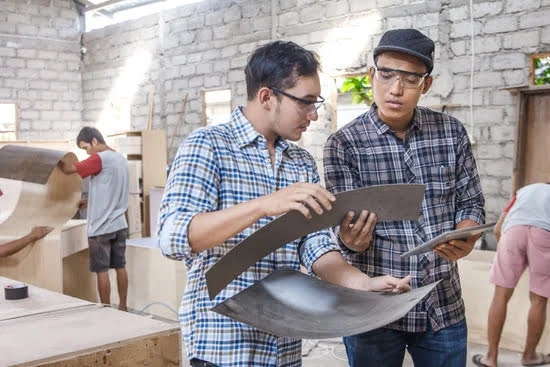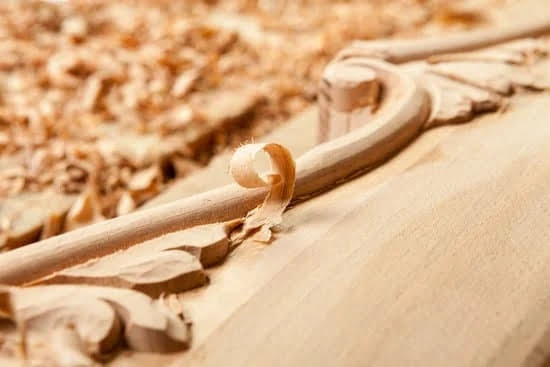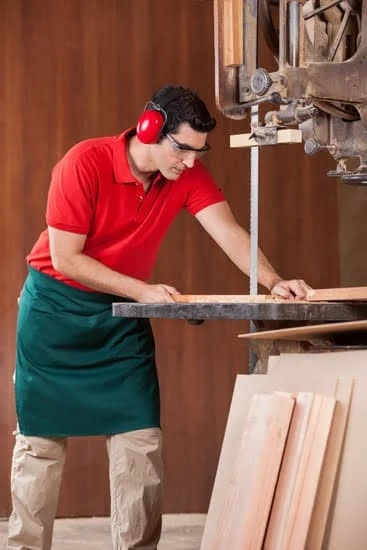Introduction
With the advancement of technology, new tools for woodworking have been introduced. However, there are some essential elements that remain unchanged over time; these items help us to perform essential tasks and processes safely and efficiently. In 2021, it is still necessary to have a set of basic tools every woodworker should own. Below are 10 essential woodworking tools you must see in 2021:
1. Saw: A good saw is necessary for making precise cuts in any kind of material. It’s important to choose the right type for its intended use because some types can cut multiple materials while others only work on one material. Some popular saws include the table saw, miter saw, circular saw, jigsaw, band saw and handsaw.
2. Hammer: Every woodworker needs a hammer or two to drive nails into wood or other materials when joining them together during construction or repair processes. The claw hammer provides a great grip while pounding and driving nails with minimal effort or injury caused by slipping off of the nail head.
3. Drills: This power tool comes in two types: standard corded drills and battery-powered cordless drills which offer more portability and convenience than the older corded version does but may not always have enough power for tougher materials like metal or stone where high torque is required for drilling holes into them without shattering beforehand . Battery powered models offer varying speed control so you don’t always have to use the highest setting available on your drill bit from start up which helps conserve energy and reduce noise levels too!
4. Router: This versatile tool allows you to shape different surfaces using different profiles such as circles, squares and other shapes depending on the design of its router bit as well creating grooves where needed with ease and finish quality that can impress even onlookers from afar! There are many types such as plunge routers, portable trimmer routers and laminate routers that come with their own respective merits making them ideal choices no matter what task needs undertaken; efficiency guaranteed!
5. Sander: Every woodworker needs a sander in order to smooth out rough surfaces before applying stains or paints which would normally go right over any imperfections if it was not processed beforehand! Sanders come in various shapes like orbital sanders (for medium size jobs) belt sanders (for larger jobs) detail sanders (for tight corner jobs). Depending on your task at hand there will almost certainly be a sander fit for purpose just waiting around nearby waiting an owner such as yourself who appreciates its potential even if mostly unaware of its presence initially!
6. Chisels: Whether hand chisels or more powerful air chisels for those hard-to-reach spots these tools provide extremely precise shaping & cutting abilities enabling them create even cutouts out of slab woods all while maintaining their initial structural integrity intact due certain characteristics related but not limited solely to their construction methodologies employed regarding manufacturing process culminating favorable results within certainly favorable timings indeed… !
7. Planers & Jointers: These indispensable machines do what most couldn’t; they take otherwise incomprehensibly large amounts of lumber & execute operations quick enough across entire batches without fail & without us having any stress about errors occurring either plus since both have distinct applications jointers should be used primarily for “joining” purposes whereas planers as expected perform “planing” operations efficient enough saving time overall one piece after another.. ! 8. Nail Gun: Having an electric nail gun takes away much of the hassle associated with nailing pieces together manually allowing users significant amounts of time when it comes completing small scale projects much faster too without breaking sweat either… Not only that they also help keep fingers affordably safe by eliminating risks associated errant mistakes during manual process would et up regular amount causing pain otherwise possibly foreseen yes… 9 Clamps/ Vises: One can never underestimate how sturdy/ secure clamps/ vises’ hold onto workpieces because they ensure grip remains constant throughout entire exercise removing occurrences related prying etc leading hazards appear near negligible pressing down etc see.. New innovations made sure safety mechanism factors incorporated well … 10 Air Compressor : Regardless job being handled indoors/ outdoors smaller projects bigger workshops certainty productivity gets instantly multiplied when obtaining access air compressors now days airbrushes act advantageously factor whose nature conducive stabilization temperatures processes thus resulting fewer complaints direct/ indirect correlations related thereto discovered prior investing precious resources hindsight … Commendable initiatives taken strides just fine…
Essential Tools
1. Hammer ” Every woodworker needs a hammer for driving nails and tacks into wood pieces to hold them together.
2. Saw ” Beginners should start with a handsaw, rather than an automated power saw. A handsaw is easier to control than an electric jigsaw or miter saw; however, skill and practice is needed to use it correctly.
3. Chisel ” A chisel is necessary for marking lines and creating grooves, mortises and dovetails, as well as making caulking joints which are essential in joining two pieces of wood together at exact points.
4. Drill ” When larger holes are desired or a hole needs to be made at an angle that cannot be achieved with just a drill bit, then one must have a powerful drill handy. Powered drills make it much easier to accurately create decorative patterns on projects such as wooden furniture.
5. Sandpaper & Sander ” Whether working by hand or using a sander, sandpaper is essential for smoothing the surface of freshly cut pieces of wood before applying paint and lacquer finishes.
6. Nail Set & Punches ” To ensure that nails are driven evenly and flush against surfaces, you’ll need nail sets and punches when using a hammer or nail gun to join two boards together securely at various angles or depths within the joint itself.
7. Plane & Smoothing Plane” Planes prevent wood from splitting while shaping edges into clean curves or joints; they also add texture to a project by shaving off tiny amounts of wood without splintering it altogether like sanding can sometimes do if not done correctly.. Furthermore, smoothing planes enable the experienced carpenter to further finesse his/her piece into perfection by further smoothing the surface (especially after assembly).
8. Measuring Tool ” No matter how experienced one may be in carpentry, measuring tools will always come in handy when determining exact dimensions for precision cuts and customization projects alike! From rulers and tape measures to T-squares, protractors and calipers measuring tools allow for certainty when cutting different types of material for any given kind of project!
9 .Clamps ” To keep components secure whilst being glued together you must clamp them in place until cured; this could either be held manually via squeezing the pliers with your hands “depending on size” or by purchasing specially adapted clamps that hold onto various sizes of boards very tightly without coming undone during any part of the glue curing process!
10 . Router – The router is used primarily to form intricate shapes in woodworking projects including decorative edging along cabinet doors; routing out internal box structures or sculpting wafer-thin reliefs in raw materials such as MDF board too! It’s essential tool once mastered enables any craftsman/woman amazing creative results with relatively low effort expended when compared to other manual operations such as carving!
Power Tools
Power tools are a vital part of woodworking and any workshop. Without these tools, many projects would take far longer to complete. This year, there is an array of power tools on the market, making it overwhelming at times to decide which ones you need and should invest in for your projects. In 2021, some of the best woodworking power tools that you should consider getting include:
1) Cordless Drills: Cordless drills are a must-have tool as they make fixing and assembling a variety of materials incredibly easy. They come with different sizes and attachments allowing them to fit into tight spaces and have the ability to drill through just about anything. With advances in battery technology, cordless drills no longer suffer from inadequate power or short runtimes.
2) Circular Saws: Circular saws are an essential tool for cutting boards into various shapes and sizes. With multiple speed settings, you can make straightforward cuts in many materials like plastic and metal without too much fuss. They also come with additional blades that can be used for more complicated cuts such as circular patterns or more intricate designs.
3) Miter Saws: Miter saws are excellent for making precise crosscuts in large boards. Modern miter saws feature laser guides that help make accurate blade adjustments quickly so you get crisp straight lines with ease every time. It is also convenient to carry around as it takes up minimal space compared to bulky table saws making it perfect for jobsite use as well as home projects.
4) Router Tables: Routers are one of the most versatile woodworking machines out there as they allow you to do a variety of operations including shape edges, cut rabbets and dados, create slots and more! Router tables provide the perfect complement for any router by providing a stable platform for complex routing operations increasing accuracy while saving time in the process.
5) Planers: Planers help smooth surfaces by removing material evenly so it’s not rough when seen up close”this can make all the difference when achieving that professional finish! Heavy duty planers offer great rigidity while being able to handle tough thick stock with ease while lighter models will let you use smaller stock with precision if necessary.
6) Band Saws: Band saws are ideal for resawing widest pieces of lumber which would otherwise be impossible on other tools such as table or circular saws due to their size or limited blade length. Using a band saw can greatly increase productivity by reducing downwork time considerably allowing you to finish your project faster than ever before!
Hand Tools
1. Chisels: Chisels are essential for any woodworker looking to create intricate details. They come in different sizes depending on the job you’re trying to do and the accuracy of your cuts. You want to make sure you choose chisels with a strong, durable handle and well-tempered blades that can stand up to the rigors of woodworking.
2. Hand Plane: A hand plane is an important tool to have in your arsenal when it comes to smoothing edges, flattening large surfaces, or removing material from a surface without leaving marks or grooves in it. There are various types of hand planes available, ranging from block planes (which are great for planing small areas) to block planes with an adjustable mouth opening (ideal for working with wider surfaces).
3. Handsaw: A handsaw is ideal for accurate cut lines and quick work, as well as taking off larger pieces of lumber than a regular saw could manage. It’s also equipped with replaceable blades so you don’t run into trouble due to dullness mid-project. There are four primary types of handsaws: crosscut saws, rip saws, dovetail saws, and backsaws ” all essential tools for successful woodworking projects.
4. Sharpening Stone: Sharpening stones are essential tools if you want your cutting utensils like saw blades, chisels and plane blades performing at their best when tackling hardwoods like cherry or oak. The two most common types are oilstones (made up of layers of finer particles) and waterstones (with aggregated particles). Selecting the right one depends on the degree of sharpening you need since each type works differently and at different rates of speed.
5. Drill Bits: Having the correct drill bits can save woodworkers a lot of time because they will be able to complete tasks that they couldn’t with traditional drill bits like countersinking screws or drilling at an angle or even drilling through laminate floors without dulling easily. Choose drill bits made out of materials that won’t wear down quickly when drilling hard metals such as stainless steel bits or cobalt steel bits.
Jigs, Clamps, and Fixtures
From jigs and fixtures, to clamps and saws, all the tools required for master-level woodworking are necessary for producing a perfect end product, but with so much available on the market it can be hard to know which tools you need. So here’s a list of 10 essential pieces of machinery you should consider investing in if you’re a passionate woodworker.
1. Table Saw: A table saw is the workhorse of any serious woodshop’, as it can handle everything from rip cuts for boards to exact cutting for mitered corner pieces.
2. Jointer: A jointer is used to flatten, true and straighten boards before they go into production. It is a key part of preparing boards quickly and accurately before they are cut or routed.
3. Router Table: A router table adds versatility and accuracy when making cuts that are not possible on a regular table saw, such as dovetails or flutes. It also helps to provide support when cutting stock over 1” thick.
4. Band Saw: The band saw is an incredibly powerful tool for resawing large lumber down into manageable sizes for your projects”and in certain cases it even lets you create curved shapes that would otherwise require extreme amounts of hand labor!
5. Miter Saw: The miter saw is one of the most accurate cutters when it comes to trimming materials like mouldings or cutting cabinet parts at odd angles”thanks largely to its adjustable blade stops and its ability to cut up to 90 degrees in either direction. This makes it essential in any master-level woodshop’.
6. Lathe: While lathes are known mainly for round turning, they can be used effectively in woodworking projects such as frame-and-panel construction or furniture refinishing work as well.
7. Scroll Saw: A scroll saw is capable of creating incredibly intricate designs that would be virtually impossible with other machines, allowing professionals or hobbyists alike to produce stunning results with minimal effort required from start to finish!
8. Jigs and Fixtures: Jigs and fixtures make complex joinery jobs easier by helping securely hold the material being worked on so there’s no worrying about sliding pieces around the workshop! These are especially useful when working on delicate components, such as instrument necks or intricate jewelry pieces like pendants or earrings.
9 . Portable Drill Press/Power Drills: No matter what type of project you’re involved with, drilling holes correctly”quickly”is always essential which means having a portable drill press (or two) is almost an absolute must in any serious woodshop’. This way you can ensure that each hole will be made exactly where needed without fear of slippage ruining your project because you?re operating at too low speed during manual operationnality.. Additionally, an electric drill (with various types of drill bits) will further help speed up drilling operations while making sure accuracy isn’t compromised either!
10 Clamps : Clamps will help secure materials together during fabrication process , allowing glue ups , or doweling applications . Be sure clamp selection covers identical sized as well as different sized joints; small spring clamps along with bar clamps both large & small will help equiped maker tackle larger projects .
Safety Gear
It’s essential for woodworkers to have the proper safety gear in 2021 to help minimize the risks that come with working with dangerous power tools. Basic protective wear should include:
1. Goggles or full-face shields – To protect your eyes from flying debris and splinters, investing in a pair of safety goggles or full-face shields is a smart move.
2. Ear protection – Woodworking can create high levels of noise, so ear plugs are strongly recommended to protect your hearing.
3. Gloves – Choose either leather work gloves or cloth gloves”the aim is to keep your hands safe from sharp tools and wood splinters, as well slivers of TBIs (threaded bit inserts).
4. Respirator masks – Depending on the type of woodworking you are doing, respirator masks may be necessary to avoid inhaling chemical fumes or harmful particles generated by cutting and torching wood projects.
5. Steel-toed boots – Experienced woodworkers understand the importance of closed-toe boots when working at the job site”even if indoor woodworking stores do not recommend them. These will protect you from potential falls, nails and other tools that may accidentally fly off while working with power tools.
Dust Collection Tools
Dust collection tools are an important part of keeping a woodworking area clean and healthy. The primary tool for dust collection is the dust collector, also known as a cyclone vacuum. The cyclone vacuum consists of a body, a motor, and hoses connected to the saws, routers, and any other power tool that can produce a lot of dust. The air flow pulls the loosened sawdust away from the area it was created in and collects it in a designated receptacle or canister for easy disposal. Connecting the power tools to the hoses helps prevent sawdust particles from entering your lungs or irritating your eyes when sanding or sawing. It’s important to note that not all cyclone vacuums are created equal; if you want better dust containment, you should choose one designed with multiple levels of filtration. This will help remove more fine particles from the air while collecting larger pieces of debris in one single pass. To reduce noise pollution produced by the system, cover any exposed pipes with insulation material or use acoustic equipment along with sound dampening materials like rubber mats on cold floors or carpets underneath hot drills and saws for best results!
Finishing Tools
Finishing tools are a vital part of any woodworking project. They are used to smooth and refine the surfaces of pieces of furniture, sculptures, and other objects. They also help to protect the wood from damage and make it look attractive. Finishing tools come in a variety of shapes and sizes: gouges, chisels, rasps, saws, files and more. When selecting finishing tools for your projects, it is important to pay attention to their quality as well as their function. Many high-end finishing tools are made from durable materials such as carbide or steel which will give them long-lasting performance while allowing you to achieve a truly outstanding finish on your projects. Additionally, there are a number of specialized finish tools available that can add greater visual detail to your finished products; these include burnishers, buffing wheels and felt bobs. No matter what type of finish tool you need for your project; spending time researching the right one will help ensure that you get a quality product that delivers excellent results each and every time.
Tool Organization
As the number of woodworking tools increases, it is becoming increasingly important to find ways to store and transport them. With so many different tool options out there, having an organized system for storing and transporting tools can make all the difference in terms of convenience and efficiency.
Tool organizers provide essential solutions for woodworkers looking to organize their stockpiles. There are plenty of different types of tool organizers available on the market today. Some are designed specifically for holding larger tools such as circular saws, routers, chisels, and planers. Others may be better suited for common hand tools such as drill bits and sandpapers. Tool bags and boxes also provide a great way to keep small items together while still being clearly labeled so that they are easy to spot when needed.
No matter the type of tool organization solution you decide on, having a well-defined plan can help ensure your most important tools stay safe during transit or storage. Wall-mounted tool racks provide efficient space saving solutions ideal for workshops with limited space available in drawers or cabinets. Modular organizers fitted into empty kitchen drawers maximize useable space as well as offering visual organization which assists in finding things quickly when needed.
Furthermore, consider investing in heavy duty cases that are made out of hard materials such as metal or plastic to ensure your equipment stays safe while traveling over distance or in transit between job sites. These cases come pre-configured with individual compartments designed specifically for different woodworking tools, making it easy seperate the various pieces from one another without occupying too much room in your work vehicle during transportation between jobsites. Ultimately, investing into appropriate tool organization can not only help manage clutter but also contribute to greater overall efficiency since all the essential items will be close at hand whenever needed!
Summary
Woodworking has become increasingly popular due to the satisfaction that comes from being able to create beautiful, unique pieces. While there are many tools needed for any woodworking project, there are some specific ones for 2021 that every craftsperson should know about.
Here is a list of 10 incredible woodworking tools for 2021 that make each piece an art form:
1. Router ” A router will help you make intricate cuts and shapes quickly and efficiently. It’s great for those looking to get into more detailed woodworking projects.
2. Table Saw ” This tool is an absolute must-have for both rookie and experienced woodworkers alike as it provides a level surface with precise cuts.
3. Jointer/Planer ” If you’re getting into more serious woodworking, then a jointer/planer is essential in order to get precisely planed boards out of rough-sawn lumber.
4. Jig Saw ” A jigsaw can help you make curved or bent cuts, which adds character to your finished product.
5. Biscuit joiner ” Biscuit joiners are used when creating strong fastened joints between different pieces of material without having to use clamps or rely on mechanical fasteners like nails or screws.
6. Palm sander” Palm sanders provide a smooth finish quickly and efficiently and can be used to refine almost any workpiece regardless of its size or shape.
7. Oscillating Multi-tool ” These versatile tools are great for cutting, sanding, grinding and much more in tight places where no other tool would fit correctly.
8. Band Saw – Band saws allow you to cut compound angles and curves due to their efficient blade design which reduces vibration while operating over long periods of time at high speeds
9 Hand Saws – Hand saws are essential as they provide accuracy when making straight cuts; they don’t require any power source so they’re ideal if you need precise results while away from electrical outlets
10 Drill Press” Drill presses offer excellent accuracy when drilling holes into materials that require careful handling, such as metals and hardwoods

Hi everyone! I’m a woodworker and blogger, and this is my woodworking blog. In my blog, I share tips and tricks for woodworkers of all skill levels, as well as project ideas that you can try yourself.





